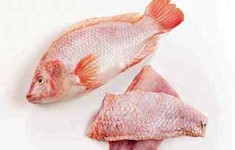 ilapia prices have edged upward year-on-year in key cultivation zones in China, the apparent result of lower cultivation by fish farmers who were burnt by lower prices in recent years. Large numbers of tilapia cultivators exited the sector in the wake of weaker demand and prices in export markets in 2009 and 2010.
ilapia prices have edged upward year-on-year in key cultivation zones in China, the apparent result of lower cultivation by fish farmers who were burnt by lower prices in recent years. Large numbers of tilapia cultivators exited the sector in the wake of weaker demand and prices in export markets in 2009 and 2010.According to tilapia farmers who spoke to Seafoodsource, prices paid to tilapia farmers in Guangdong province (a key cultivation zone) broke the RMB 5 (USD 0.81, EUR 0.62) per 500g mark on 10 March, hitting RMB 5.2 (USD 0.84, EUR 0.64) per 500g while the so-called “pond price” of larger (1.75kg) tilapia rose to RMB 8.3 (USD 1.35, EUR 1.02) for 500g. Since then, prices have ebbed slightly but remain strong. Price data from the two key production regions, Hainan and the Pearl River Delta (Guangdong), published by China’s national seafood sales network Shuichan Pindao (Aquatic Products Channel) shows tilapia selling for an average RMB 4.7 (USD 0.76, EUR 0.58) per 500g in April. That’s a significant climb on RMB 4 (USD 0.65, EUR 0.49) recorded at the same period in 2012.
Erratic prices have already pushed cultivators out of the sector. The biggest tilapia culture base in Guangdong province, Pingsha Wan Mu, suggested fries will be down 50 percent on last year. Pingsha has 16,000 mu (15mu =1 hectare) of pond space. “From 2010, the price of tilapia kept in low position, the tilapia farmers lost a lot and most of them decided to culture some other fishes which have higher economic values,” according to a report in the Nanfang Metropolis Daily, the most widely read newspaper in Guangdong.
According to the Nanfang Metropolis Daily “since there are less tilapia farmers, the tilapia fry suppliers are getting less orders this year. This is a new situation in this industry.” The newspaper also states several other key factors effecting cultivation, including industrial pollution. “As well as the low economic values and easy spread of infectious diseases, another reason causing less farmers to culture tilapia is that many factories were moved next to the culturing bases in recent year, and that makes the water get polluted easily, causing the death of tilapia fries.”
China’s tilapia prices are volatile in part due to the highly fragmented nature of the sector. That could be changing however, with well-financed conglomerates like feed firm Tongwei and processor Baiyang in recent years entering the cultivation space. Market leader Baiyang in 2012 exported 362,000 tons of frozen tilapia, according to company chairman Sun Zhongyi. Baiyang however only has a 9 percent market share, proof of the very fragmented nature of the sector.
Despite price volatility, there’s still plenty of appetite among tilapia producers to lift output, particularly in China’s poorer regions where government organizes and subsidizes production as a way of lifting rural incomes. The Guangxi Tilapia Innovation Team — a state-funded body under the provincial agricultural authorities — recently produced a new species of tilapia named “Baigui No.1,” comparing to the normal tilapia, this new one has stronger growing ability, which will help farmers to increase their incomes. The Guangxi provincial agricultural department reported on its website that after trailing for several months, “a batch of ‘Baigui No.1’ tilapia grew from 0.2 grams to 200 grams … due to the growing speed, this batch of tilapia will fetch a good market price in no more than two months.”
Also in Guangxi province, tilapia farmers in Bobai county have started culturing tilapia in hot spring ponds in winter. According to Li Yong, director of the Bobai Cooperative Society (of 1,630 farmers) “we have solved the problem about how to breed tilapia in winter, by using the hot springs, we can breed two groups of tilapia in a year, which improves the efficiency of culturing.” The cooperative currently cultivates 30,000 tons for exports to mostly America and Europe worth RMB 300 million (USD 48.7 million, EUR 36.9 million) a year.







